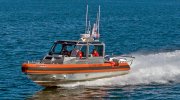Will be going iceberg hunting in the East Coast & have never flown over open seas. I have flown several times over rapids with my Mavic 2 Pro before I acquired my Mavic 3. Here are a few of my questions:
1. Do I set my RTH to “Smart RTH”. Something tells me I should not set via height because the cliff I launched from is higher?
2. Seems unanimous that I turn OFF Obstacle Avoidance but isn’t the only way to do this is set the drone to “Sport Mode”?
3. For hand catching on a boat, I have read a lot of people saying to set Obstacle Avoidance to “Brake” which makes it easier. I have hand caught on dry land but never in open seas!
I have a Firehouse Arc II strobe light mounted at the top rearmost point on my Mavic 3 so I can keep VLOS as these icebergs could be as far as 2km from shore. I will also be using my Asus ROG 5 mobile gaming phone that has 2 USB-C ports that I can as an option connect my Epson Moverio BT-40 smartglasses to get a clear FPV view of what I’m shooting along with keeping VLOS at all times. Was planning on getting the RC Pro but decided not to because of random disconnect issues stated in various forums. I will be using UAV Forecast app to monitor for ideal flight conditions as I will be spending a week iceberg hunting.
Any advice on flying in the environments I just described above would be greatly appreciated. Thanks in advance!
1. Do I set my RTH to “Smart RTH”. Something tells me I should not set via height because the cliff I launched from is higher?
2. Seems unanimous that I turn OFF Obstacle Avoidance but isn’t the only way to do this is set the drone to “Sport Mode”?
3. For hand catching on a boat, I have read a lot of people saying to set Obstacle Avoidance to “Brake” which makes it easier. I have hand caught on dry land but never in open seas!
I have a Firehouse Arc II strobe light mounted at the top rearmost point on my Mavic 3 so I can keep VLOS as these icebergs could be as far as 2km from shore. I will also be using my Asus ROG 5 mobile gaming phone that has 2 USB-C ports that I can as an option connect my Epson Moverio BT-40 smartglasses to get a clear FPV view of what I’m shooting along with keeping VLOS at all times. Was planning on getting the RC Pro but decided not to because of random disconnect issues stated in various forums. I will be using UAV Forecast app to monitor for ideal flight conditions as I will be spending a week iceberg hunting.
Any advice on flying in the environments I just described above would be greatly appreciated. Thanks in advance!
Last edited:














